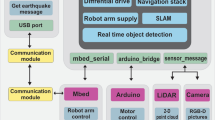Abstract
In order to reduce the harmfulness of explosion crime to society, this paper improves the coordinate transformation algorithm from the perspective of bomb demolition, and builds a motion control system suitable for EOD robots. Moreover, this article combines image recognition algorithms to improve machine vision, and obtains an intelligent recognition system suitable for EOD robots. In addition, the optical model of the monocular camera is established to calibrate the camera's own parameters, and a series of image processing algorithms are used for visual image processing to obtain the plane position information of the target object. After the robot recognizes the position of the bomb, it gradually approaches the bomb, its coordinates are constantly changing, and the collected data is transmitted to the data processing center to realize real-time control of the EOD robot. Finally, this paper verifies the reliability of the EOD robot through simulation tests.








Similar content being viewed by others
References
Clayton GM (2018) Mechatronics for humanitarian explosive ordnance disposal in Cambodia. Mech Eng 140(09):S4–S10
Deng W, Zhang H, Li Y et al (2018) Research on target recognition and path planning for EOD robot. Int J Comput Appl Technol 57(4):325–333
Gertz N (2018) Hegel, the struggle for recognition, and robots. Techné Res Philos Technol 22(2):138–157
Horváth T (2019) Emergencycases at countering improvised explosive devices (C-IED), and their potentialmanagement. Land Forces Acad Rev 24(2):95–106
Jang GR, Bae JH, Lee DH et al (2018) 3D information based visualization system for real-time teleoperation of unmanned ground vehicles. J Korea Robot Soc 13(4):220–229
Jiang D, Zheng Z, Li G et al (2019) Gesture recognition based on binocular vision. Clust Comput 22(6):13261–13271
Jo KS, Lee DH, Kim GS (2019) Design of high performance manipulator for small EOD robot system. J Korean Soc Precis Eng 36(12):1125–1133
Kim J, Bae Y, Lee I et al (2020) Study on output characteristics of printed flexible tactile sensors connected to brass terminals. J Korean Soc Manuf Process Eng 19(4):65–70
Kwon HJ (2018) Analysis of the robot for detection of improvised explosive devices and a technology for the CNT based detection sensor. J Semicond Display Technol 17(1):54–61
Li H, Song A, Li H et al (2018) Design of EOD robot measurement and control system based on ethernet. Measur Control Tech 37(007):5–8
Li G, Li J, Ju Z et al (2019) A novel feature extraction method for machine learning based on surface electromyography from healthy brain. Neural Comput Appl 31(12):9013–9022
Li G, Tang H, Sun Y et al (2019) Hand gesture recognition based on convolution neural network. Clust Comput 22(2):2719–2729
Matejka J (2017) Bezposádkový pozemný prostriedok ako multiplikátor sily boja v zastavaných priestoroch. Vojenské rozhledy 26(4):119–134
Mathiassen K, Schneider FE, Bounker P et al (2021) Demonstrating interoperability between unmanned ground systems and command and control systems. Int J Intell Defence Support Syst 6(2):100–129
Oh YT (2018) Studyof semi disruptor robot, W mobility and sens. Technology 9(12):1043–1056
Pamungkas AAS, Sangaji D, Adityo MF et al (2019) Design and implementation of six degree of freedom manipulator for field service robot. J Instrum Autom Syst 4(1):1–4
Riza AN, Arifin I, Pratama M et al (2019) Design of power distribution on operator control unit (OCU) Rhino robot. IPTEK J Pro Ser 30:83–87
Tamara TT, Affandi A, Arifin I et al (2019) Graphical user interface optimalization based C# with visual studio to operator control unit Rhino robot. IPTEK J Proc Ser 54–57
Xiong W, Chen Z, Wu H et al (2018) Fetching trajectory planning of explosive ordnance disposal robot. Ferroelectrics 529(1):67–79
Yin Q, Xiong Z, Song S et al (2018) Modular design method of EOD robot based on genetic algorithm. Int J Wireless Mobile Comput 15(2):185–193
Funding
The research is supported by: Key scientific research projects of Henan Provincial Department of Education: “21B880031” Research on the innovation of Ideological and political education method in Public Security Colleges Based on the theory of network group dynamics; Teaching reform project of Railway Police College: “JY2020010” Research on the three dimensional model of Crime Scene Investigation Training Teaching.
Author information
Authors and Affiliations
Corresponding author
Ethics declarations
Conflict of interest
The authors declared that they have no conflicts of interest to this work. I declare that I do not have any commercial or associative interest that represents a conflict of interest in connection with the work submitted.
Additional information
Publisher’s Note
Springer Nature remains neutral with regard to jurisdictional claims in published maps and institutional affiliations.
Rights and permissions
About this article
Cite this article
Guo, J. Research on the application of intelligent robots in explosive crime scenes. Int J Syst Assur Eng Manag 14, 626–634 (2023). https://doi.org/10.1007/s13198-021-01428-w
Received:
Revised:
Accepted:
Published:
Issue Date:
DOI: https://doi.org/10.1007/s13198-021-01428-w




